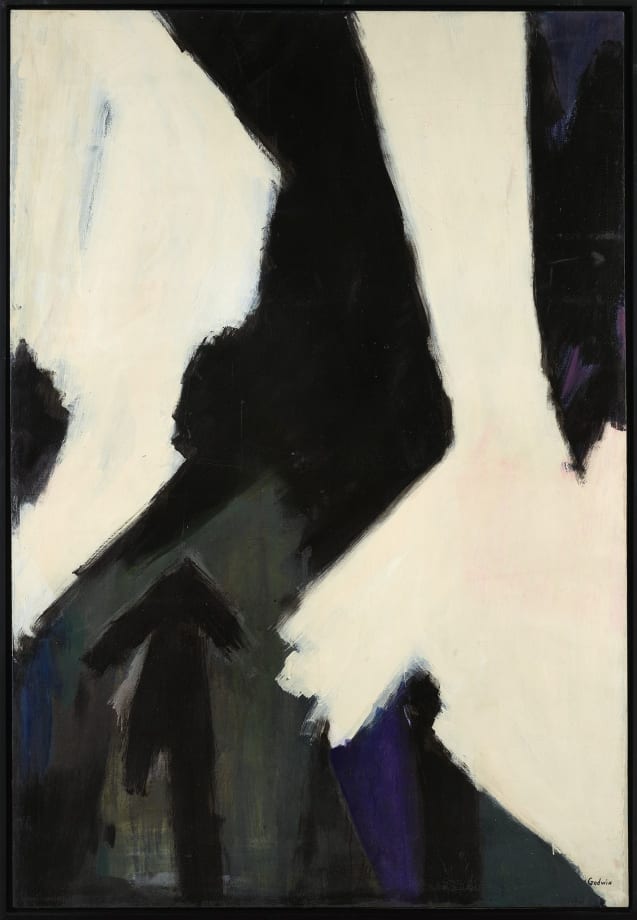With twenty-three works on display from 1954 to 1959, Modern Woman reveals Godwin’s distinct style of Abstract Expressionism, which synthesizes the feminine with the masculine. Godwin creates a symphony of rhythms as ethereal washes in luminous color vibrate against powerful somber tones. Works from this period draw on the female body, relationships, and nature.
This exhibition is the first time in over sixty years that a show has been devoted exclusively to Godwin’s works from the 1950s. Over sixty years later, Modern Woman highlights Godwin’s relevance in today’s world and furthers Berry Campbell’s commitment to advancing the legacies of postwar women artists.
Like many other women artists of her generation, Godwin received less attention in the mid and late twentieth century from the press and public than her male counterparts. However, the steadfast creativity and accomplishments of Godwin and other women of her time have become increasingly acknowledged and given overdue consideration. Among the recent efforts at such restitution was the June to September 2016 groundbreaking exhibition, Women of Abstract Expressionism, at the Denver Art Museum. Godwin was among twelve artists in the exhibition, including Lee Krasner, Joan Mitchell, Perle Fine, and Helen Frankenthaler. Godwin’s art has also been represented in recent solo museum exhibitions and written about in numerous publications. Her works are on view in Action, Gesture, Paint, Women Artists and Global Abstraction (1940-70) which began at the Whitechapel Gallery, London and is currently at the Fondation Vincent van Gogh, Arles.
Modern Woman will feature numerous works that have not been seen by the public in over sixty years, some since her 1960 exhibition at Betty Parsons Sections Eleven. Spirit – Ode to Martha Graham, 1956, not only reveals her reverence for her close friend Graham but also employs delicate washes of oil to suggest fleeting bodily movements. To Ann Barclay, 1955 dedicated to Godwin’s partner at the time, uses abstraction as a pure language to explore her most intimate relationship. The use of inky black bars in Night, 1958 serves to ignite the shimmering gold and white tones from the background, suggesting a radiance only visible at night.
Berry Campbell has published a 96-page monograph in conjunction with this exhibition. Aliza Edelman, editor of the Woman’s Art Journal, wrote the main essay for monograph, entitled Modern Women, Dancing Bodies: Judith Godwin’s Abstract Expressionism in the 1950s, from which the title of this exhibition is taken. Contributions to the monograph were made by Gwen Chanzit, curator emerita at the Denver Art Museum, and Anthony Korner, former publisher of Artforum.With twenty-three works on display from 1954 to 1959, Modern Woman reveals Godwin’s distinct style of Abstract Expressionism, which synthesizes the feminine with the masculine. Godwin creates a symphony of rhythms as ethereal washes in luminous color vibrate against powerful somber tones. Works from this period draw on the female body, relationships, and nature.
This exhibition is the first time in over sixty years that a show has been devoted exclusively to Godwin’s works from the 1950s. Over sixty years later, Modern Woman highlights Godwin’s relevance in today’s world and furthers Berry Campbell’s commitment to advancing the legacies of postwar women artists.
Like many other women artists of her generation, Godwin received less attention in the mid and late twentieth century from the press and public than her male counterparts. However, the steadfast creativity and accomplishments of Godwin and other women of her time have become increasingly acknowledged and given overdue consideration. Among the recent efforts at such restitution was the June to September 2016 groundbreaking exhibition, Women of Abstract Expressionism, at the Denver Art Museum. Godwin was among twelve artists in the exhibition, including Lee Krasner, Joan Mitchell, Perle Fine, and Helen Frankenthaler. Godwin’s art has also been represented in recent solo museum exhibitions and written about in numerous publications. Her works are on view in Action, Gesture, Paint, Women Artists and Global Abstraction (1940-70) which began at the Whitechapel Gallery, London and is currently at the Fondation Vincent van Gogh, Arles.
Modern Woman will feature numerous works that have not been seen by the public in over sixty years, some since her 1960 exhibition at Betty Parsons Sections Eleven. Spirit – Ode to Martha Graham, 1956, not only reveals her reverence for her close friend Graham but also employs delicate washes of oil to suggest fleeting bodily movements. To Ann Barclay, 1955 dedicated to Godwin’s partner at the time, uses abstraction as a pure language to explore her most intimate relationship. The use of inky black bars in Night, 1958 serves to ignite the shimmering gold and white tones from the background, suggesting a radiance only visible at night.
Berry Campbell has published a 96-page monograph in conjunction with this exhibition. Aliza Edelman, editor of the Woman’s Art Journal, wrote the main essay for monograph, entitled Modern Women, Dancing Bodies: Judith Godwin’s Abstract Expressionism in the 1950s, from which the title of this exhibition is taken. Contributions to the monograph were made by Gwen Chanzit, curator emerita at the Denver Art Museum, and Anthony Korner, former publisher of Artforum.

